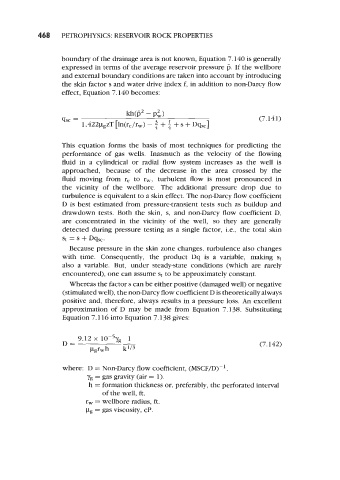Page 500 - Petrophysics
P. 500
468 PETROPHYSICS: RESERVOIR ROCK PROPERTIES
boundary of the drainage area is not known, Equation 7.140 is generally
expressed in terms of the average reservoir pressure p. If the wellbore
and external boundary conditions are taken into account by introducing
the skin factor s and water drive index f, in addition to non-Darcy flow
effect, Equation 7.140 becomes:
(7.141)
This equation forms the basis of most techniques for predicting the
performance of gas wells. Inasmuch as the velocity of the flowing
fluid in a cylindrical or radial flow system increases as the well is
approached, because of the decrease in the area crossed by the
fluid moving from re to r,, turbulent flow is most pronounced in
the vicinity of the wellbore. The additional pressure drop due to
turbulence is equivalent to a skin effect. The non-Darcy flow coefficient
D is best estimated from pressure-transient tests such as buildup and
drawdown tests. Both the skin, s, and non-Darcy flow coefficient D,
are concentrated in the vicinity of the well, so they are generally
detected during pressure testing as a single factor, ix., the total skin
St = s + Dqsc.
Because pressure in the skin zone changes, turbulence also changes
with time. Consequently, the product Dq is a variable, making st
also a variable. But, under steady-state conditions (which are rarely
encountered), one can assume st to be approximately constant.
Whereas the factor s can be either positive (damaged well) or negative
(stimulated well), the non-Darcy flow coefficient D is theoretically always
positive and, therefore, always results in a pressure loss. An excellent
approximation of D may be made from Equation 7.138. Substituting
Equation 7.1 16 into Equation 7.138 gives:
(7.142)
where: D = Non-Darcy flow coefficient, (MSCF/D)-l.
yg = gas gravity (air = 1).
h = formation thickness or, preferably, the perforated interval
of the well, ft.
r, = wellbore radius, ft.
pg = gas viscosity, cP.

